One LED flare replaces U.S. required pyros, Sirius Signal but not Ocean Signal
The pitch is compelling. The $100 Sirius Signal SOS C-1001 LED "flare" isn't just a floating SOS flasher visible at night "up to 10+ nautical miles...for at least 6 hours." It is also the only such device that meets the U.S. Coast Guard requirements for an electric distress light and can thus permanently replace the three pyrotechnic flares otherwise required on all U.S. recreational vessels over 16 feet operating in coastal waters, the Great Lakes, and many major rivers (and on even smaller boats at night). Given that the cheapest flare set costs about $33 and expires 42 months after manufacturing (and you might not want the cheapest because pyros are inherently dangerous to you and the environment), the Sirius substitute may be a "no brainer"...
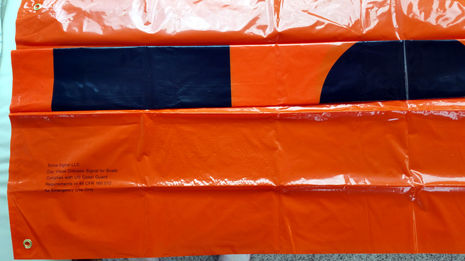 Actually, the $100 Sirius Signal Distress Light kit also includes an orange plastic Distress Flag (sold separately here), so that it completely meets the USCG requirements for day and night visual distress signals. And company co-founder Bob Simons spent 35 years conducting Vessel Safety Checks as a volunteer CG Auxiliarist and reports that the most common failure is expired flares. That, and a partner with manufacturing and lighting expertise, is how Sirius Signal came to be.
Actually, the $100 Sirius Signal Distress Light kit also includes an orange plastic Distress Flag (sold separately here), so that it completely meets the USCG requirements for day and night visual distress signals. And company co-founder Bob Simons spent 35 years conducting Vessel Safety Checks as a volunteer CG Auxiliarist and reports that the most common failure is expired flares. That, and a partner with manufacturing and lighting expertise, is how Sirius Signal came to be.
At any rate, the 36 x 36 inch distress flag seems well made, consisting of two plastic layers sewn together and then brass grommeted so it can be clearly displayed (black square over black circle the preferred orientation).
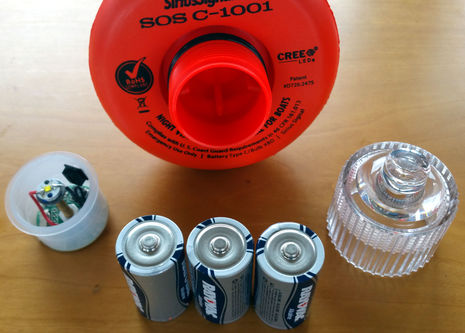 The Sirius LED flare also seems well made and quite simple in design (aside from the diode's little circuit board). There's only one light mode and to activate it you just screw the lens/cap a turn or two tighter. Being slightly skeptical about this type of "switch", I shook the deactivated light vertically and even banged it down hard while upside down. But it did not light up accidentally, and I think it remains waterproof in the off mode because there are two well-spaced O rings protecting the ingress area just below the body threads.
The Sirius LED flare also seems well made and quite simple in design (aside from the diode's little circuit board). There's only one light mode and to activate it you just screw the lens/cap a turn or two tighter. Being slightly skeptical about this type of "switch", I shook the deactivated light vertically and even banged it down hard while upside down. But it did not light up accidentally, and I think it remains waterproof in the off mode because there are two well-spaced O rings protecting the ingress area just below the body threads.
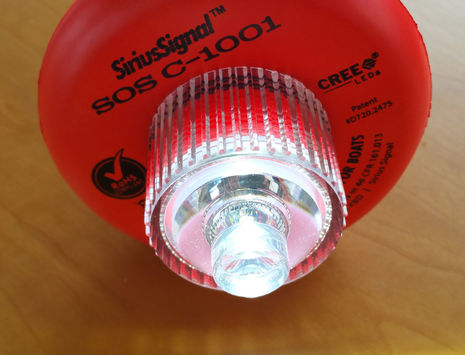 I have not tried this distress light in realistic conditions -- that's tricky, though I hope to eventually figure out a test method that doesn't confuse anyone -- but I can tell you that the single Cree LED and the molded lens combined are too bright to look at closely even in a lit room, and that while the light is particularly focused on the horizontal plane, there's also a skyward component for aircraft and helicopters. The Morse code SOS signal (· · · - - - · · ·) is also well articulated with effective pauses between the letters.
I have not tried this distress light in realistic conditions -- that's tricky, though I hope to eventually figure out a test method that doesn't confuse anyone -- but I can tell you that the single Cree LED and the molded lens combined are too bright to look at closely even in a lit room, and that while the light is particularly focused on the horizontal plane, there's also a skyward component for aircraft and helicopters. The Morse code SOS signal (· · · - - - · · ·) is also well articulated with effective pauses between the letters.
Incidentally, MarineBeam -- also a source of Gizmo's beloved Ultra Long Range LED flashlight and white LED running lights -- supplied this test sample from their stock, but the Sirius Signal SOS light kit is also available from Defender and other sources.
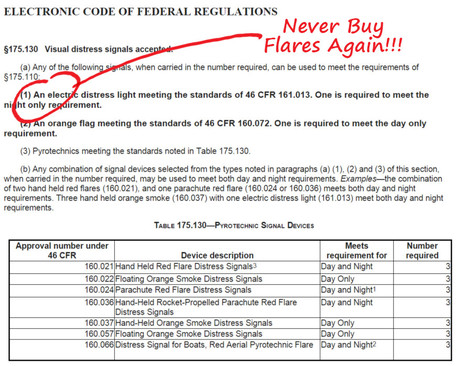 The visual distress signal requirement that Sirius Signal screen captured above can be found in 33 CFR 175.130, which then references 46 CFR 161.013 for the actual electric distress light standards. The requirements seem pretty complicated, particularly in terms of light intensity, but what is obvious is why other existing electronic flares cannot be self-certified by their manufacturers.
The visual distress signal requirement that Sirius Signal screen captured above can be found in 33 CFR 175.130, which then references 46 CFR 161.013 for the actual electric distress light standards. The requirements seem pretty complicated, particularly in terms of light intensity, but what is obvious is why other existing electronic flares cannot be self-certified by their manufacturers.
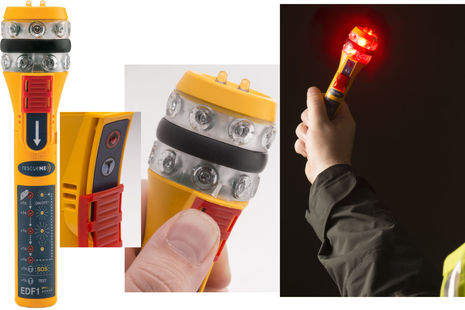 The Ocean Signal EFD1, for instance, looks like a very effective LED distress light. Besides SOS signalling with a "range up to 7 miles", it has three other useful modes as well as the ability to test the state of its Lithium battery. However, it does not meet 46 CFR 161.013 standards because it cannot "Float in fresh water with the lens surface at or above the surface of the water," and also because its light is red, not white. Interestingly, though, an Ocean Signal representative recalls that the color red was chosen because it's "better to distinguish as an emergency signal" and also because red LEDs "have a higher actual light output both measured and perceived."
The Ocean Signal EFD1, for instance, looks like a very effective LED distress light. Besides SOS signalling with a "range up to 7 miles", it has three other useful modes as well as the ability to test the state of its Lithium battery. However, it does not meet 46 CFR 161.013 standards because it cannot "Float in fresh water with the lens surface at or above the surface of the water," and also because its light is red, not white. Interestingly, though, an Ocean Signal representative recalls that the color red was chosen because it's "better to distinguish as an emergency signal" and also because red LEDs "have a higher actual light output both measured and perceived."
Which brings us to the point that there may well be a difference between the safety equipment that you're required to carry and the added safety equipment that makes sense for your particular boating situation.
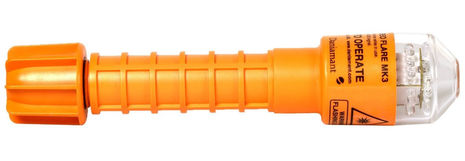 Another LED flare contender then is the Odeo MK3 model above ($185 at Landfall), and let's note that the Odeo MK1 broke trail in electric distress devices. I was also impressed with ACR's new Aurora pyro flares when I saw them demoed in Miami, and I think that pyros can be more effective in certain circumstances. The BoatU.S. Foundation has good info on pyro flare types and uses, though I believe I found the final words on visual distress signals in Practical Sailor. Frank Lanier (just Panbo'd here his excellent ICW Guide review) began a review of the Odeo MK2 thusly:
Another LED flare contender then is the Odeo MK3 model above ($185 at Landfall), and let's note that the Odeo MK1 broke trail in electric distress devices. I was also impressed with ACR's new Aurora pyro flares when I saw them demoed in Miami, and I think that pyros can be more effective in certain circumstances. The BoatU.S. Foundation has good info on pyro flare types and uses, though I believe I found the final words on visual distress signals in Practical Sailor. Frank Lanier (just Panbo'd here his excellent ICW Guide review) began a review of the Odeo MK2 thusly:
Like winning lottery tickets and accurate head shots during the zombie apocalypse, visual distress signals are one of those things you just can't have too many of.
PS May 23, 2016: Since there seem to be some who doubt that the Sirius Signal SOS LED device really fufills the "electric distress light" standard that's been in the CFR for a long time, it's great that a Panbo reader who is also a volunteer US Power Squadron Vessel Examiner sent in this recent clarification from the USPS Safety Committee:
UPDATE FOR VESSEL EXAMINERS AND Boat Owners
SIRIUS SIGNAL LIGHT
Vessel Examiners should be aware of the capabilities and approvals of the SIRIUS SOS C-1001 electronic distress light. This light is acceptable as a nighttime visual distress signal.
SIRIUS has included a daytime distress flag in the SOS C-1001 packaging so that it can market the package as a solution for a combined day/night signal, and as a replacement for flares. As long as the SIRIUS Signal Model SOS C-1001 is carried in conjunction with an acceptable daytime distress signal, this satisfies the daytime/nighttime signaling requirement.
All electronic visual distress signals, in order to be acceptable, must be legibly and indelibly marked with the statement: "Night Visual Distress Signal for Boats Complies with U.S. Coast Guard Requirements in 46 CFR §161.013. For Emergency Use Only", and must also be marked with the manufacturer's name, replacement battery type and lamp size.
If an electric light is designed for use with dry cell batteries the label must advise the consumer on the battery replacement schedule, which under normal conditions would maintain performance requirements of 46 §CFR 161.013-3
When conducting a vessel safety check, all Auxiliary Vessel Examiners (VEs)and Power Squadron examiners are to check/verify this piece of safety equipment in accordance with the Vessel Safety Check Manual, COMDTINST M16796.8A.

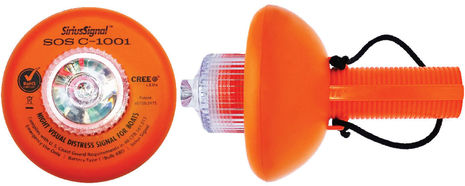
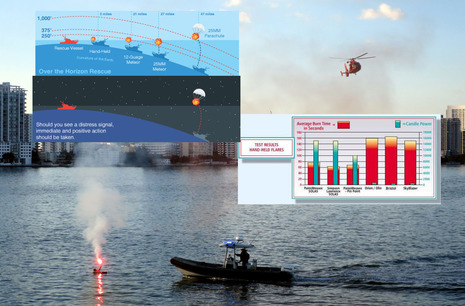
 Share
Share
Orion 12 ga. flares are only $22 at Walmart, for a 4-pack.
Their stock is fresh, so you generally get close to the 42 months from them.
LEDs have their use, particularly when tethered to a PFD for MOB use, but in my opinion, if you are really concerned about being seen while still afloat, nothing beats a SOLAS-rated parachute flare, but they are very expensive, and do expire. I have only one, in a waterproof Pelican box, supplemented by the Orion 12 ga.,
and a Fenix high lumen LED flashlight (with SOS mode) tethered to my inflatable PFD.
Once you meet the minimum USCG requirements, all else is just frosting on the cake, and if stored properly, most expired pyrotechnics still function as back-ups.
And, any aerial flare will attract more notice than one at water-level, especially in bright daylight. Just my opinion.